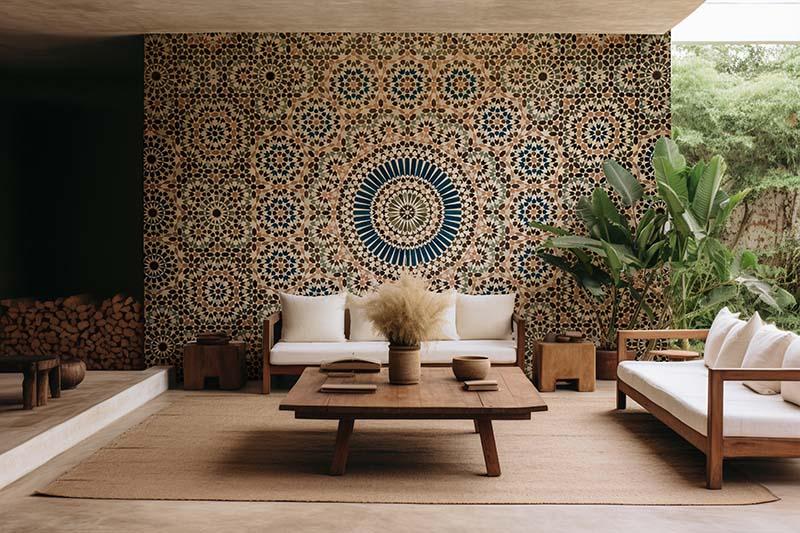Few elements are as powerful when it comes to adding character, colour, and craftsmanship to your interiors as Moroccan tiles. These beautiful, intricate tiles have been celebrated for centuries for their vivid patterns, bold colours, and artisanal charm. Moroccan tiles, especially when used on walls, transform ordinary spaces into vibrant masterpieces that exude a warm and exotic vibe.
In this article, we explore the beauty of Moroccan tiles for wall applications, their benefits, and how you can creatively incorporate them into your home or commercial spaces.
What Are Moroccan Tiles?
Originating from Morocco, these tiles are deeply rooted in the country’s rich cultural and artistic traditions. Moroccan tiles are typically handmade and feature intricate geometric patterns, arabesques, and vibrant colours like cobalt blue, emerald green, saffron yellow, and deep reds. Known as zellige (pronounced zel-ij), these tiles are crafted using traditional techniques passed down through generations.
Each tile is slightly different, giving an authentic, handcrafted look that no machine-made product can replicate. This uniqueness makes Moroccan tiles especially beloved among interior designers and homeowners seeking to create distinctive and soulful spaces.
Why Choose Moroccan Tiles for Your Walls?
1. Artisanal Beauty
Moroccan tiles bring a unique artistic flair that immediately catches the eye. Each pattern tells a story, adding layers of history and culture to your walls.
2. Vibrant Colours and Patterns
The bold, colourful designs can either complement neutral spaces with a pop of colour or create an all-out statement wall that becomes the highlight of the room.
3. Versatility
Moroccan tiles can be used in various spaces—kitchens, bathrooms, living rooms, courtyards, and even commercial establishments like cafes, hotels, and boutiques.
4. Durability
Despite their delicate appearance, Moroccan tiles are strong and durable. With proper installation and care, they can last for decades without losing their beauty.
5. Easy Maintenance
Their glazed surface makes them relatively easy to clean, a practical benefit for walls in areas prone to splashes and stains, such as kitchens and bathrooms.
Best Places to Use Moroccan Tiles on Walls
Kitchen Backsplash
A Moroccan tile backsplash adds a burst of colour and pattern, turning a functional area into a beautiful focal point. Pair them with plain cabinetry to balance the visual impact.
Bathroom Walls
Create a spa-like retreat with Moroccan tiles behind the vanity, in the shower, or as an accent wall. The vivid colours and designs can make even small bathrooms feel luxurious and lively.
Living Room Accent Wall
In the living room, a Moroccan tiled feature wall can serve as a dramatic backdrop for minimalist furniture or eclectic decor.
Entryways and Hallways
Set the tone right from the entrance by cladding your foyer walls with Moroccan tiles. They create an immediate and unforgettable impression on guests.
Outdoor Walls
Moroccan tiles are perfect for adding charm to garden walls, patios, or balcony areas, making outdoor spaces feel like an exotic escape.
Tips for Styling Moroccan Wall Tiles
-
Mix with Neutrals: To prevent the space from feeling too busy, balance Moroccan tiles with neutral walls, floors, and furniture.
-
Frame Sections: Instead of tiling an entire wall, you can frame a section with tiles for a modern and elegant look.
-
Blend Patterns Carefully: If you love eclectic looks, you can mix different Moroccan patterns, but keep a consistent colour palette for harmony.
-
Consider Tile Size: Larger tiles can make spaces feel more cohesive, while smaller zellige mosaics add intricate detail.
Conclusion
Moroccan tiles for walls are not just a design choice—they're an experience. They bring centuries of craftsmanship, vibrant artistry, and undeniable warmth into your home or commercial space. Whether you want a full feature wall or a small splash of colour, Moroccan tiles offer endless possibilities to express your style in a truly timeless way.
